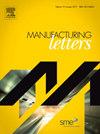Effect of drying temperature on binder/current collector interfacial adhesion in electrode manufacturing of Li-ion batteries
IF 1.9
Q3 ENGINEERING, MANUFACTURING
引用次数: 0
Abstract
Li-ion battery manufacturing process parameters are critical to the electrode properties and the final cell electrochemical performance. During the electrode drying process, the drying temperature plays a critical role on the binder migration, which affects the interfacial adhesion between the electrode and the current collector. However, the influence of the temperature on the properties of the binder material and the binder/current collector interface is yet unknown. In this work, we studied the effect of drying temperature on the interfacial adhesion between the binder and the current collector by direct coating of polyvinylidene fluoride (PVDF) solution on Al foil and then drying at various temperatures. The interfacial adhesion strength between the PVDF and the Al foil was significantly increased, from 9.72 N/m (dried at room temperature) to > 665.80 N/m (dried at 200 ℃) with increased temperature. DSC and XRD analyses showed the changes in the crystalline forms of PVDF under different drying temperature. This work revealed that the drying temperature during electrode manufacturing should be considered from the aspects of both binder migration in mid-stage and PVDF crystalline properties in late-stage solvent drying.
干燥温度对锂离子电池电极制造中粘合剂/集流体界面粘附力的影响
锂离子电池制造工艺参数对电极特性和最终电池的电化学性能至关重要。在电极干燥过程中,干燥温度对粘结剂的迁移起着至关重要的作用,而粘结剂的迁移会影响电极与集流体之间的界面粘附力。然而,温度对粘结剂材料和粘结剂/集流器界面性能的影响尚不清楚。在这项工作中,我们通过在铝箔上直接涂覆聚偏二氟乙烯(PVDF)溶液,然后在不同温度下干燥,研究了干燥温度对粘合剂和集流器之间界面粘附力的影响。随着温度的升高,聚偏二氟乙烯(PVDF)与铝箔之间的界面粘附强度显著增加,从 9.72 N/m(室温下干燥)增加到 > 665.80 N/m(200 ℃ 下干燥)。DSC 和 XRD 分析表明了不同干燥温度下 PVDF 晶体形态的变化。这项工作揭示了电极制造过程中的干燥温度应从中期粘合剂迁移和后期溶剂干燥时的 PVDF 结晶特性两方面加以考虑。
本文章由计算机程序翻译,如有差异,请以英文原文为准。
求助全文
约1分钟内获得全文
求助全文
来源期刊

Manufacturing Letters
Engineering-Industrial and Manufacturing Engineering
CiteScore
4.20
自引率
5.10%
发文量
192
审稿时长
60 days
 求助内容:
求助内容: 应助结果提醒方式:
应助结果提醒方式:


